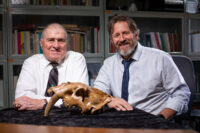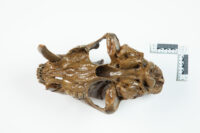 The complete fossilized skull of a sabretooth cat (Smilodon fatalis) has been discovered on the banks of the East Nishnabotna River in southwest Iowa. Radiocarbon testing results date the skull to between 13,605 and 13,460 years before the present. Sabretooth cats went extinct after the glaciers began to recede about 13,285 years ago, so this specimen was one of the last on the continent.
The complete fossilized skull of a sabretooth cat (Smilodon fatalis) has been discovered on the banks of the East Nishnabotna River in southwest Iowa. Radiocarbon testing results date the skull to between 13,605 and 13,460 years before the present. Sabretooth cats went extinct after the glaciers began to recede about 13,285 years ago, so this specimen was one of the last on the continent.
Very few Smilodon fossils have been found anywhere in North America outside of Rancho La Brea, California (home of the famed La Brea Tar Pits), and they are mostly isolated teeth, bones and partial crania. A complete cranium is exceptional in its own right, and this specimen is particularly notable as the first evidence that the late Pleistocene carnivore once roamed what is now Iowa.
“We think southwest Iowa during this period was a parkland with patches of trees interspersed with grassy openings, somewhat similar to central Canada today,” said [Matthew Hill, an associate professor of archaeology at Iowa State]. “The cat would have lived alongside other extinct animals like dire wolf, giant short-faced bear, long-nosed peccary, flat-headed peccary, stag-moose, muskox, and giant ground sloth, and maybe a few bison and mammoth.”
 Comparison of the Iowa cranium to ones from the same date range found at La Brea indicate the big cat was a subadult male about two or three years of age at time of death. His cranial sutures were not fully formed, and there was no wear on his molars and premolars, indicating they were recent eruptions. This juvenile cat was still huge, of course. Researchers estimate it weighed about 550 pounds, about 100 pounds from its adult maximum and 150 pounds more than the average African male lion today.
Comparison of the Iowa cranium to ones from the same date range found at La Brea indicate the big cat was a subadult male about two or three years of age at time of death. His cranial sutures were not fully formed, and there was no wear on his molars and premolars, indicating they were recent eruptions. This juvenile cat was still huge, of course. Researchers estimate it weighed about 550 pounds, about 100 pounds from its adult maximum and 150 pounds more than the average African male lion today.
One of the dramatic long canines that give these cats their name is broken, and the small amount of wear on the nub that remains indicates the creature died no more than a few days after he was injured. This is unlikely to be a coincidence. The sabretooth cat’s injury (an attack on prey gone wrong, maybe?) probably killed him. It just took a couple of days to finish the job.
Hill suspects the cat’s primary prey was Jefferson’s giant ground sloth, which were common in Iowa during the Ice Age. They’d sit beside trees and bushes and pull in leaves and buds to eat. At 8-to-10 feet tall and over 2,200 pounds, giant ground sloths were massive. Hill believes only a large predator armed with “absolutely lethal jaws and claws” and legs designed for pouncing could hunt them regularly.
To test this, Hill is teaming up with his Iowa State colleague Andrew Somerville. The assistant professor of archaeology is an expert in dietary reconstruction using bone geochemistry. Together, they’re developing a stable isotope mixing model with samples from the sabretooth cat, other carnivores, and herbivores (e.g., Jefferson’s ground sloth, muskox, stag-moose.)
“You are what you eat, and it’s locked in your bones,” explained Hill.
Stable isotopes make it possible for researchers to know what plants herbivores eat and, in turn, what herbivores carnivores eat. They can piece together local food webs and how species filled ecological niches.
“So, maybe the sabretooth was primarily eating giant ground sloth, dire wolves primarily moose, and short-faced bears a little bit of everything. Andrew and I are going to figure it out,” said Hill.
550lb? That’s one laaarge pussycat. Our Theo is a big four year old Maine Coon cross and weighs about 14lb!